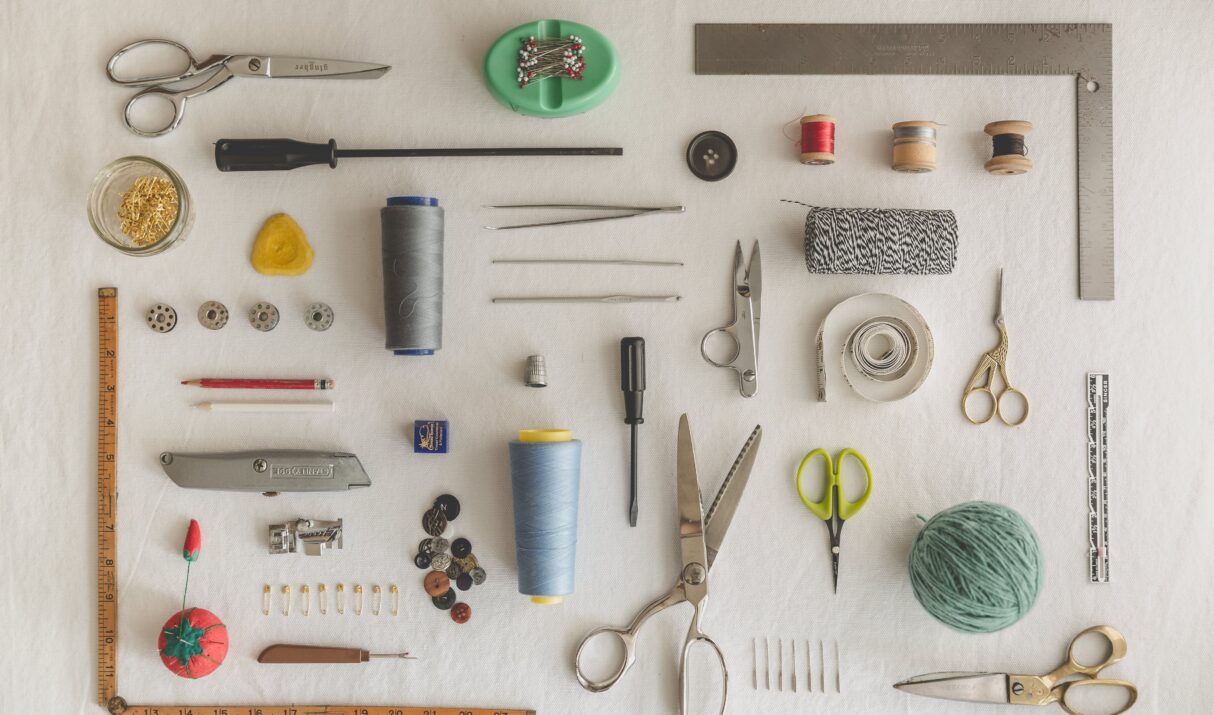This post may include affiliate links. Please read my disclaimer page for more info. So, you’ve decided to take the plunge and start learning to sew—excellent choice, by the way. You’re excited and maybe tempted to rush to the craft store or fill your online cart with every sewing tool under the sun. Trust me I’ve been there. Most of it I didn’t even use right away. So before you go on a spending spree, here’s a list of the actual beginner must-haves so you can start smart without overspending. 🌸 1. Sewing Machine Do you need a sewing machine right away? Not necessarily. I didn’t even get mine until about three months after I started sewing. So what was I doing before that? Hand sewing! Wait—people still do that? Yes. And that’s my recommendation for you as well. Think of it like building a house—you wouldn’t jump straight to the roof without laying the foundation first, right? It’s the same with sewing. Hand sewing helps you understand the basics, develop control, and build the patience that sewing requires. That said, if you’re eager to jump in with a machine, go for it, just don’t go overboard. A basic model is more than enough when you’re starting out (especially if you’re not 100% sure you’ll stick with it). Look for something with simple stitch options, a clear manual, and good beginner reviews. You’ll learn faster with less frustration, and your wallet will thank you. What to Look for in a Beginner Machine: Straight stitch and zigzag stitch (that’s all you need to start) Easy threading system 1 Step Auto Button Hole Manual speed control Budget-friendly and durable (brands like Brother, Singer, and Janome are great for beginners) Personally, I would recommend the SINGER Heavy Duty 4423. I love this machine and it’s perfect for beginners. 2. Needles Whether you’re sewing by hand or with a machine, needles are a must. I actually had no idea there was a difference between hand sewing needles and sewing machine needles. Thankfully your machine will come with needles to help you get started which is nice. How often should you change those needles? Its recommended to change your sewing machine needle after every 8 hours of sewing or every 2–3 projects, though to definitely keep mind a bit longer. Types of Sewing Needles: Hand Sewing Needles: Choose sharp, medium-length needles (called “sharps”) for everyday use. Use longer needles (“milliners”) for basting or gathering. Machine Needles: Start with universal needles, size 80/12 or 90/14 for cotton or medium-weight fabrics. Pro Tip: Change your needle often. Dull needles cause skipped stitches and fabric snags. 3. Pins Pins hold your fabric in place before you sew. They may be small, and hard to find when you drop them, but they’re essential. Types of Pins: Glass Head Pins: These are heat resistant and great for ironing. They don’t melt on your fabric like the plastic ones. Ballpoint Pins: Best for knits—they slide between fibers instead of piercing. Extra Fine Pins: Perfect for delicate fabrics like silk and satin. Storage Tip: Keep them in a pin cushion or magnetic holder to avoid mess (and stepping on them). You can also consider getting clips as well. They don’t leave little holes in the fabric and are ideal for securing fabric layers. I recommend getting both. 4. Scissors Do yourself a favor and invest in a good pair. A sharp, high-quality pair of fabric scissors will make clean, precise cuts. It’s very important that you cutting your fabric properly as it will come back to haunt you while sewing. Types to Consider: Fabric Scissors: Only use them on fabric—no paper or plastic! When I first started I used mine for cutting paper and wondered why it had gotten dull so quickly. Lesson learned. Paper Scissors: You’ll need them if you’re working with patterns. Embroidery Scissors: Small and sharp, ideal for snipping threads. Pinking Shears: Zigzag edges help reduce fabric fraying. I started out with just fabric scissors and paper scissors. The last two are nice to have, but you can get them at a later time. I got this Black Titanium Fabric Scissors back in September, but it’s a bit heavy so if you want something lighter you can also checkout the Fiskars 8” Original. Quick Tip: Label your fabric scissors clearly so no one else uses them for the wrong purpose. 5. Threads I had no idea there were so many kinds of thread until I really got into sewing. I used to just buy those cheap value packs from the store anytime I needed to fix a seam. When I started, I didn’t think twice about it. I just grabbed whatever was cheapest. But those threads would fray, break, or tangle mid-project, and I didn’t understand why. Turns out, there are tons of thread types for different fabrics and projects: cotton, polyester, silk, and even denim-specific thread. My tip? If you’re new, start simple. All-purpose polyester thread is strong, reliable, and super versatile. Once you get more comfortable, you can experiment with specialty threads later on. Stick to brands like Gütermann or Coats & Clark for quality. 6. Tape Measure You’ll need a soft measuring tape for taking body measurements or measuring fabric. I have multiple. It was one of the first tools I picked up, and I still use it all the time. Why does it matter? Accurate measurements mean better-fitting garments, cleaner cuts, and fewer mistakes. Choose a double-sided one with inches on one side and centimeters on the other. 7. Marking Tools When I first started sewing, I used tailor’s chalk. It got the job done, but it broke a lot and didn’t always mark clearly. These days, I prefer heat-erasable or water-soluble pens, they glide on smoothly and vanish with a little heat or water. Super easy. Marking tools are super important. They help you layout seams, darts, and pattern lines before you even think about cutting. And since you’ll probably make a few
